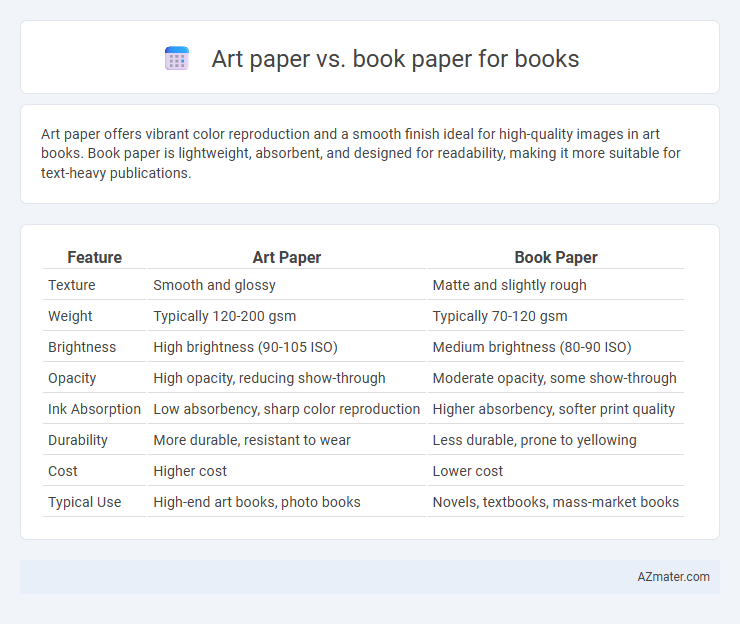Art paper offers vibrant color reproduction and a smooth finish ideal for high-quality images in art books. Book paper is lightweight, absorbent, and designed for readability, making it more suitable for text-heavy publications.
Table of Comparison
| Feature | Art Paper | Book Paper |
|---|---|---|
| Texture | Smooth and glossy | Matte and slightly rough |
| Weight | Typically 120-200 gsm | Typically 70-120 gsm |
| Brightness | High brightness (90-105 ISO) | Medium brightness (80-90 ISO) |
| Opacity | High opacity, reducing show-through | Moderate opacity, some show-through |
| Ink Absorption | Low absorbency, sharp color reproduction | Higher absorbency, softer print quality |
| Durability | More durable, resistant to wear | Less durable, prone to yellowing |
| Cost | Higher cost | Lower cost |
| Typical Use | High-end art books, photo books | Novels, textbooks, mass-market books |
Understanding Art Paper and Book Paper
Art paper is typically coated, offering a smooth, glossy or matte finish ideal for high-quality image reproduction and vibrant color accuracy in books such as photo books or art catalogs. Book paper, often uncoated or lightly coated, prioritizes readability and durability, featuring a slightly textured surface that reduces glare and suits text-heavy books like novels or academic publications. Understanding the specific characteristics of art paper versus book paper helps publishers select the best material to enhance the book's visual appeal and reading experience.
Key Characteristics of Art Paper
Art paper is distinguished by its high brightness, smooth surface, and superior opacity, which enhance image sharpness and color vibrancy in printed books. Its heavier weight and coated finish reduce ink absorption, resulting in crisp, vivid illustrations ideal for photo books and art catalogs. Compared to standard book paper, art paper offers exceptional durability and a premium tactile feel, making it the preferred choice for visually rich publications.
Essential Features of Book Paper
Book paper is designed for durability, readability, and optimal ink absorption, featuring a smooth surface with moderate opacity to prevent show-through and minimize eye strain during extended reading. It typically has a weight ranging from 50 to 90 gsm, balancing thickness and flexibility to ensure comfortable handling and efficient binding. In contrast, art paper prioritizes high gloss and vibrant color reproduction, making it less suitable for traditional text-heavy books where clarity and legibility are essential.
Printing Quality: Art Paper vs Book Paper
Art paper offers a smooth, glossy surface that enhances color vibrancy and sharpness, making it ideal for high-quality photo books and art reproductions. Book paper generally has a matte finish with lower brightness, providing better readability and less glare for text-heavy books. Printing quality on art paper excels in detail and saturation, while book paper prioritizes clarity and comfort for long reading sessions.
Visual Appeal and Color Reproduction
Art paper offers superior visual appeal and color reproduction due to its smooth, coated surface that enhances vibrancy and sharpness of images, making it ideal for photo books and art catalogs. Book paper, typically uncoated and more porous, absorbs ink more readily, resulting in muted colors and less detail clarity, best suited for text-heavy publications. Choosing art paper elevates the aesthetic quality, ensuring rich, accurate color representation, while book paper prioritizes readability and cost-efficiency.
Texture and Feel in Reader Experience
Art paper features a smoother, glossier texture that enhances color vibrancy and image sharpness, creating a luxurious and tactile reader experience. Book paper generally offers a more matte, porous surface that reduces glare and provides a comfortable, easy-to-read feel during extended reading sessions. The choice between art paper and book paper significantly impacts how readers engage with the physicality of the book, influencing both visual appeal and tactile comfort.
Durability and Longevity Comparison
Art paper typically exhibits higher durability and longevity than standard book paper due to its heavier weight, acid-free composition, and resistance to yellowing over time. Book paper, often thinner and more acidic, tends to degrade faster, becoming brittle and discolored with prolonged exposure to light and air. Choosing art paper enhances the lifespan and preservation of printed materials, making it ideal for archival-quality books that require lasting durability.
Best Book Genres for Art Paper
Art paper, known for its smooth texture and high opacity, is ideal for genres like graphic novels, children's picture books, and photography books, where vibrant colors and sharp details are crucial. Its thicker, coated surface enhances the visual appeal of illustrations and photographs, providing a premium feel that complements visually rich content. Conversely, book paper suits text-heavy genres such as novels and biographies, emphasizing readability and cost-effectiveness over image quality.
Ideal Book Types for Book Paper
Book paper is ideal for novels, textbooks, and reference books due to its lightweight, opaque, and durable qualities that enhance readability and reduce eye strain during long reading sessions. Its smooth texture and high opacity prevent text bleed-through, making it suitable for densely printed pages and extensive text. Art paper, with its glossy finish and heavier weight, is generally better for image-rich art books and photo albums but less practical for text-heavy books where comfort and cost-efficiency are priorities.
Choosing the Right Paper for Your Book
Art paper offers a smooth, glossy finish that enhances images with vibrant colors and sharp details, making it ideal for photo books or art reproductions. Book paper, typically uncoated and matte, provides better readability and reduces eye strain, suited for novels, textbooks, and general reading materials. Selecting the right paper depends on the book's content and purpose, balancing visual appeal with reader comfort and durability.

Infographic: Art paper vs Book paper for Book
 azmater.com
azmater.com